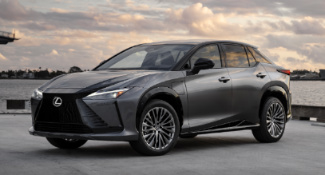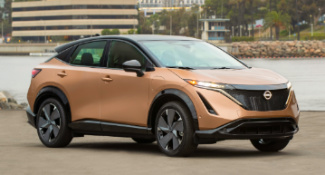Vehicle Type: A four-door, five-seat compact crossover SUV.
Price Range: From $28,025 to $42,775, including a $1,225 destination charge.
Powertrain: A 187-horsepower, 2.5-liter four-cylinder engine with a six-speed automatic transmission and all-wheel-drive (AWD).
A 256-horsepower, turbocharged 2.5-liter four-cylinder engine with a 6-speed automatic and all-wheel-drive.
What’s New for 2022?
The Mazda CX-50 is a new vehicle for 2023. It's Mazda's fourth SUV on sale now and is slightly larger and more expensive than the CX-5. And it's also the first Mazda built at a new factory in Alabama.
What’s Good?
- Potent turbocharged engine option
- High-quality interior materials
- Standard all-wheel-drive on all models
- Relatively good on-road performance
What’s Bad?
- Base engine isn't especially powerful
- In-car technology is unimpressive
- No hybrid or electric option, with only average fuel economy
- On the pricier end of mainstream compact SUVs
Would we buy one? Probably. The CX-50 is a highly refined compact SUV and does a convincing job of rivaling premium SUVs for more mainstream prices. But the related Mazda CX-5, while an older design, is also an accomplished premium SUV for less money.
More Photos:
See more 2023 Mazda CX-50 Photos.
Overview:
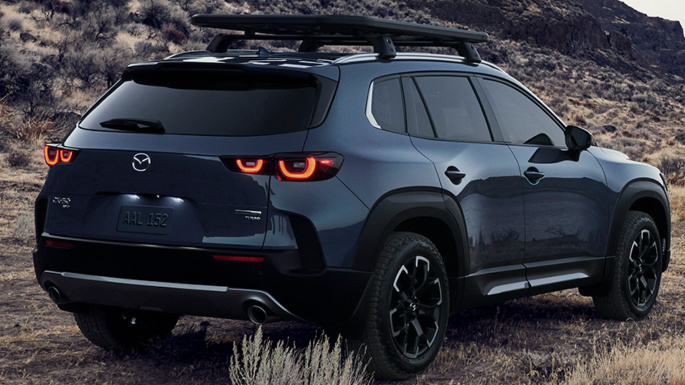
The 2023 Mazda CX-50 is an all-new vehicle in its lineup and its second compact SUV. Joining the long-standing and popular CX-5, the CX-50 is slightly larger and is pitched as a somewhat more upscale and versatile vehicle.
Both models are offered with two four-cylinder engines, with or without a turbo, and a 6-speed automatic and all-wheel-drive. It also rides on a longer wheelbase than the CX-5, as well as being slightly wider, according to Mazda’s specs.
Rivals for the Mazda CX-50 include the Acura RDX, Buick Envision, Cadillac XT4, Chevrolet Equinox, Ford Bronco Sport, Ford Escape, GMC Terrain, Honda CR-V, Hyundai Santa Fe, Hyundai Tucson, Infiniti QX50, Jeep Cherokee, Jeep Compass, Kia Sorento, Kia Sportage, Lexus NX, Lincoln Corsair, Mazda CX-5, Mini Countryman, Mitsubishi Outlander, Nissan Rogue, Subaru Forester, Subaru Outback, Toyota RAV4, Toyota Venza, Volkswagen Tiguan, and Volvo XC40.
Overall Score: 3.6/5 stars
Driving Experience: 4/5 stars
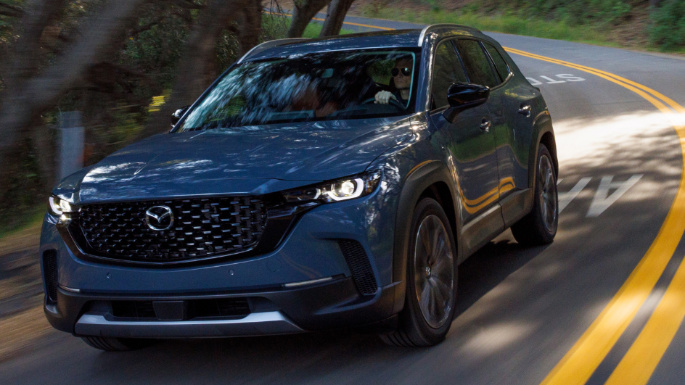
Mazda's vehicles tend to shine in how they drive, and the CX-50 is no exception. It may be larger than the CX-5, but that doesn't dull the driving experience too much. Communicative steering and controls meet a ride that isn't too harsh, even with the 20-inch wheels, and it combines to make the CX-50 one of the most entertaining compact SUVs at any price.
The CX-50 is also pitched as something of an off-road vehicle, unlike the very street-oriented CX-5. While the Ford Bronco Sport, Jeep Compass or Cherokee, Subaru Forester, or Outback can be more capable, the CX-50 boasts good ground clearance and has a standard all-wheel-drive. Mazda's selectable drive modes even include an off-road mode in addition to regular and sport settings and a towing mode on turbo models.
The standard 187-horsepower engine is likely adequate for how most owners will use the CX-50, but it isn't anything special. Even the turbo model we tested felt like it could use more grunt, though we did appreciate its livelier with its 320 lb-ft of torque.
And while the six-speed automatic escapes the drawbacks of the continuously variable transmissions (CVTs) found in many mainstream rivals, most conventional transmissions have seven, eight, or 10 speeds now.
Safety Features: 4/5 stars
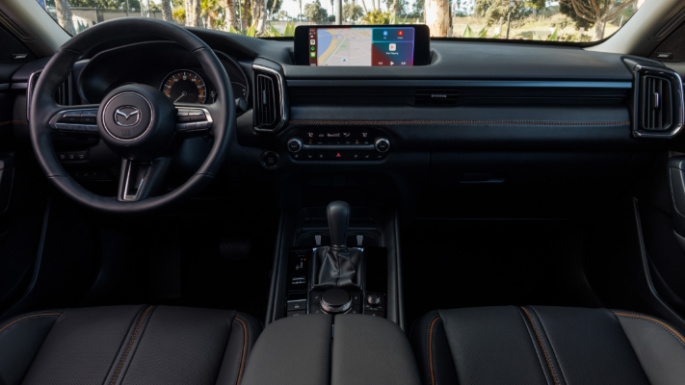
Every CX-50 comes standard with a comprehensive suite of driver assistance technology. Automatic emergency braking, high beam assist, blind-spot warning, lane-departure warning, and a driver attention monitor come on every version. The top Turbo Premium Plus also includes active assists, parking sensors, and a 360-degree camera.
However, neither the National Highway Traffic Safety Administration (NHTSA) nor the Insurance Institute for Highway Safety (IIHS) tested the CX-50. But Mazdas tend to do well in crash tests, so the CX-50 shouldn't be an exception.
Value: 3/5 stars
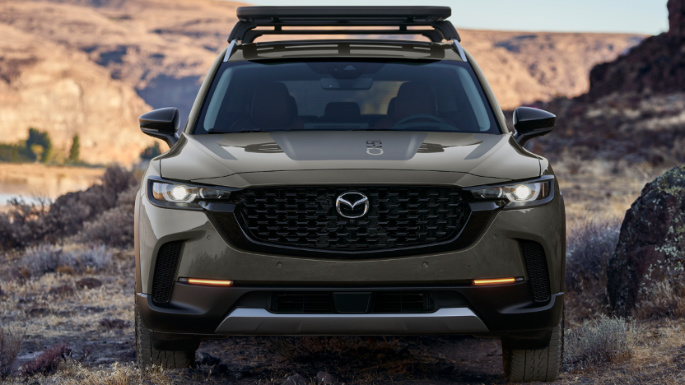
The base CX-50 starts at just over $28,000, and the least-expensive turbocharged model is in the $37,000 range. That's roughly $1,000 more than a comparable 2022 CX-5, which already runs a little more expensive than other mainstream compact SUVs.
And the base CX-50 is somewhat sparsely equipped, so it requires another $1,500 to step up to the Select model to get things like privacy glass, keyless entry, and dual-zone climate control. Because of Mazda's rigid equipment packaging, satellite radio and a panoramic moonroof require going up to nearly $36,000. That leaves buyers to consider which features are essential.
A loaded Turbo Premium Plus model pushes past $43,000, which is well out of the range of models like the Hyundai Tucson and Subaru Forester, even when factoring in the horsepower difference.
But it puts the Mazda in line with base versions of SUVs from Infiniti and Lincoln, for example, and those wouldn't have the same equipment at the same price.
Tech Features: 3/5 stars
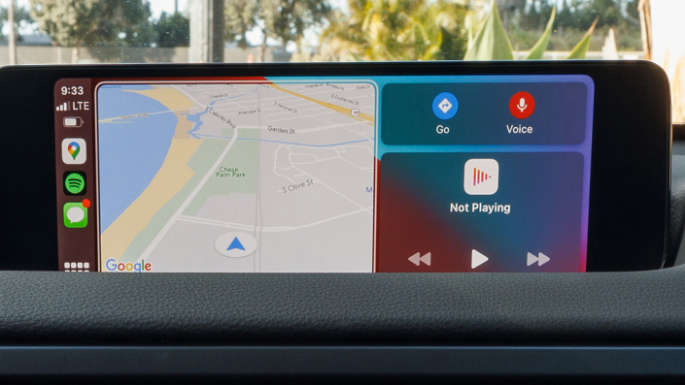
The new Mazda infotainment system launched in 2019, adding larger screens like the 10.25-inch version on all but the base CX-50. It also includes wireless Apple CarPlay on every model and Android Auto connectivity. But compared to simpler touchscreen systems on nearly every other competitor, Mazda's wheel-driven system is more complicated than it needs to be, and the menus can be confusing.
There are some other problems, too. For example, the base model doesn't include USB charging ports for rear passengers, and only the most expensive model gets wireless smartphone charging, despite the widespread wireless CarPlay. It's also the only version to get a 360-degree surround-view camera.
That said, there are some pluses. For example, a head-up display is widely available, as is a 12-speaker Bose audio system. These are upscale touches many mainstream rivals don't offer at all.
Practicality: 4/5 stars
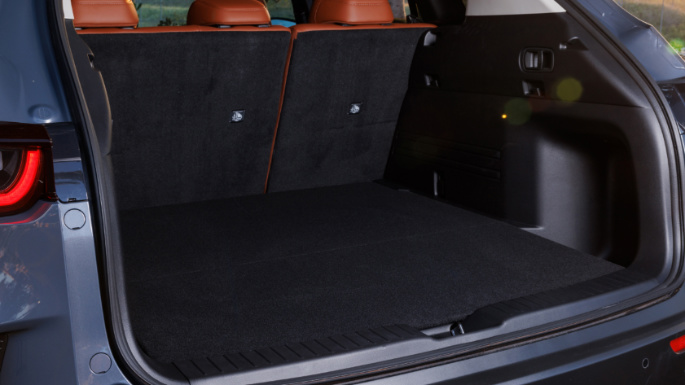
With 31.4 cubic feet of cargo space with the seats up and 56.3 with the rear seats folded, the CX-50 is usefully larger than the CX-5. But that vehicle is on the smaller end of the space ratings of the class. Still, the CX-50's upright shape doesn't impede too much on usable cargo, and it's still relatively low, so loading isn't a problem.
There’s significantly more legroom in the CX-50 than the CX-5, and it’s pretty good for any compact SUV. But headroom, strangely, is reduced. It’s worth a test drive to see if any of that affects functionality.
Towing capacity is up to 2,000 pounds with the non-turbo engine and up to 3,500 with the turbo engine. And ground clearance is up to 8.6 inches, depending on the model. That's considerably more than many of its road-oriented competitors.
Styling & Design: 5/5 stars

As it makes moves on premium brands, Mazda has included numerous upscale touches on every CX-50. Even the base model comes with 17-inch alloy wheels, while more expensive versions get the 20s. And the wider stance makes it look more aggressive than most rivals, save for the Bronco Sport.
The premium feel is most evident inside, though, with high-quality materials nearly everywhere. Only the base model comes with cloth upholstery, while most use leatherette or leather. But everything that's in the line of sight looks and feels good.
Controls are relatively simple, too, with physical controls for volume and climate settings. Rear passengers get an armrest and cupholders, too. But the 40/20/40 split-folding back seat that the CX-5 offered isn't here — it's a simple 60/40 split.
Efficiency: 3/5 stars
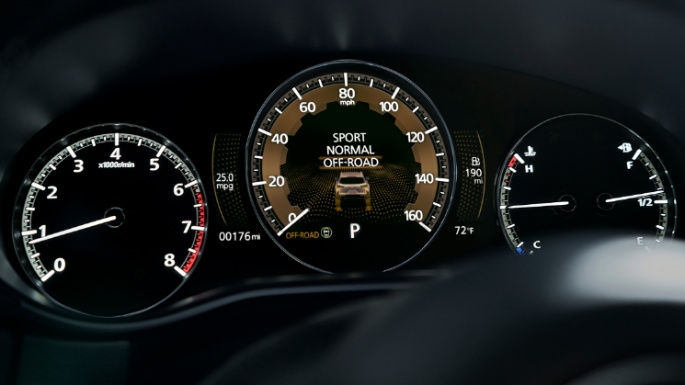
The EPA rates the non-turbo CX-50 at 24 mpg city, 30 combined, and 27 combined. The turbo models lose 1 mpg city and highway and get 25 mpg combined.
In our 330 miles of testing (in a loaded turbo model), we averaged 22.4 miles per gallon. That's about what we'd see on comparable vehicles with similar power -- be it a turbo four-cylinder engine or a V6.
The Nissan Rogue AWD is rated at 31 mpg combined, the Toyota RAV4 between 28 and 30, and the Subaru Forester at 26 or 29 mpg, depending on the model. The CX-5, however, does slightly worse at 24 or 26 mpg, and the VW Tiguan is rated at 24 or 25 mpg.
Among its more upscale rivals, the Acura RDX averages 23 mpg, the Buick Envision 25, and the Mini Countryman 26 mpg.
However, more of the CX-50's long list of rivals offer hybrid, plug-in hybrid (PHEV), or full electric variants. Mazda says a CX-50 hybrid is in the cards but hasn't given many details. And the turbocharged engine only makes its full 256 horsepower on 91 octanes or higher, with 227 horsepower on 87.
What’s it Going to Cost Me?
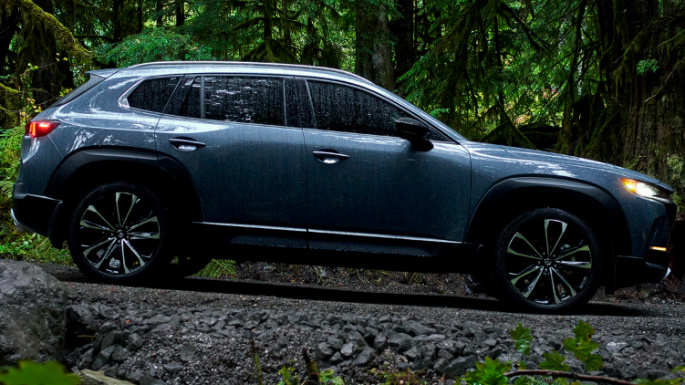
The 2023 Mazda CX-50 starts from $28,025 and rises to $42,775, including the $1,225 destination charge. There are nine trim levels for 2023: 2.5 S, 2.5 S Select, 2.5 S Preferred, 2.5 S Preferred Plus, 2.5 S Premium, 2.5 S Premium Plus, 2.5 Turbo, 2.5 Turbo Premium, and 2.5 Turbo Premium Plus. Because of this selection, there are no factory options other than some extra-cost exterior paint colors, which range from $395 to $595.
The CX-50 2.5 S starts at $28,025 MSRP. Standard equipment includes a 187-horsepower, 2.5-liter four-cylinder engine, six-speed automatic transmission, all-wheel-drive, Mazda Intelligent Drive Select modes, and auto on/off LED headlights with automatic high beam assist, rain-sensing windshield wipers, and gray 17-inch alloy wheels. The 2.5 S also includes a push-button start, a height-adjustable driver's seat, a 60/40 split-folding rear seat, and cloth upholstery.
Mazda's infotainment system includes an 8.8-inch display, Bluetooth compatibility, wireless Apple CarPlay, Android Auto compatibility, two front console-mounted USB ports, a 3-year trial for Mazda Connected Services, and a 7-inch LCD display in the instrument panel. Driver assistance technology includes automatic emergency braking, blind-spot monitoring with rear cross-traffic alert, adaptive cruise control, lane-departure warning, and a driver attention alert.
The 2.5 S Select starts at $29,425 and adds rear privacy glass, black-finished 17-inch wheels, keyless entry, dual-zone automatic climate control, a sunglasses holder, and leatherette upholstery, leather-wrapped steering wheel and gear lever, a 10.25-inch infotainment display, two rear USB charging ports, and HD radio.
The 2.5 S Preferred starts at $30,725. It adds a windshield wiper de-icer, heated exterior mirrors, a power liftgate, an 8-way power driver's seat with lumbar adjustment, and heated front seats.
The 2.5 S Preferred Plus starts at $33,165. In addition to the Preferred's equipment, it adds a powered panoramic moonroof.
The 2.5 S Premium is priced at $35,625. It includes more equipment, such as an auto-dimming rearview mirror with a Homelink garage door opener, leather upholstery, 2-position memory settings for the driver's seat, and a 12-speaker Bose audio system with a 3-month SiriusXM satellite radio trial.
The 2.5 S Premium Plus starts at $37,625 and adds power-folding exterior mirrors, 20-inch wheels, ventilated front seats, and a head-up driver's display.
The 2.5 Turbo also starts at $37,625. It includes the 256-horsepower, turbocharged 2.5-liter four-cylinder engine, LED taillights, adaptive front headlights, a 6-way power front passenger seat, and steering-wheel-mounted steering wheel paddle shifters for the transmission. However, it loses the power-folding mirrors, ventilated seats, 12-speaker audio system, and head-up display from the 2.5 S Premium Plus.
The 2.5 Turbo Premium starts at $40,775 and adds to the base Turbo power-folding side mirrors with 2-position memory settings, ventilated front seats, a heated steering wheel, 12-speaker Bose audio system, satellite radio, and a head-up display.
Finally, the top 2.5 Turbo Premium Plus is priced at $42,775. This was the model we tested and we came away impressed with how luxurious it felt, even for the money.
This version includes an auto-dimming driver's side exterior mirror, heated rear seats, a wireless smartphone charger, a built-in navigation system, traffic sign recognition, front and rear parking sensors, rear automatic emergency braking, lane-keep assist, traffic jam assist, blind-spot assist, and a 360-degree surround-view monitor.
If it were us, we'd pick the 2.5 Turbo Premium. The CX-5 is still a worthy rival against mainstream SUVs like the Honda CR-V and Toyota RAV4 and the one to go for if you're shopping for those kinds of vehicles. As a slightly more upscale vehicle, though, the Turbo Premium includes many desirable features that put the CX-50 on par with a highly-equipped Subaru Outback or a base Volvo XC40 or Acura RDX.
